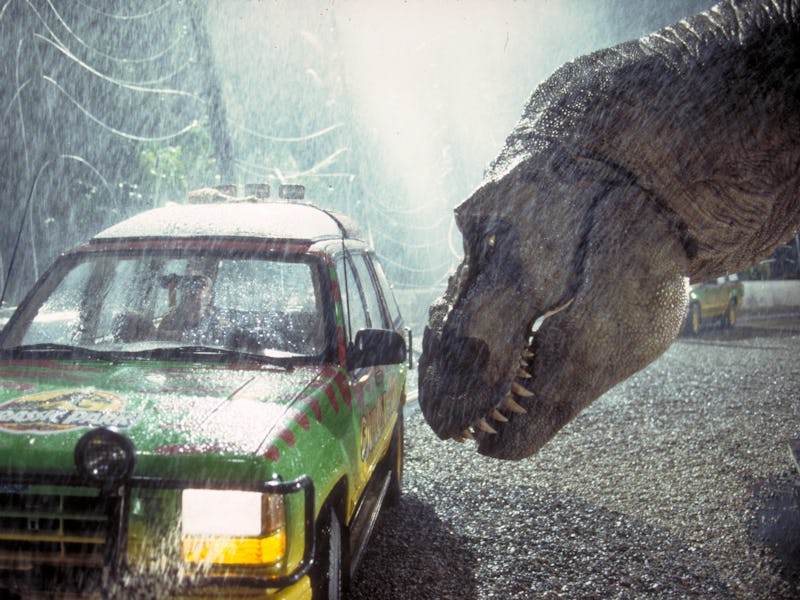For the surprisingly slow T. rex "life was a marathon, not a sprint"
When you're on top, you can take it easy.

The Tyrannosaurus rex was scary, sure, but getting away from its powerful bite and five-foot-long skull might have been easier than you would think.
In an iconic Jurassic Park scene, as the ragtag team speeds away from a charging T. rex in an open-top jeep, Dr. Ian Malcolm advises they "must go faster!" It's known as a chase scene for a reason — the T. rex is chasing them.
But new research indicates that these big boys didn't actually do much chasing. Because of its unique physiology, the T. rex was most efficient when walking.
This finding was published Wednesday in the journal PLOS ONE.
[See the card story: T.rex Wasn't a Speed Demon]
"Objects in mirror are closer than they appear."
To come to that conclusion, researchers collected data on 70 species of theropod dinosaurs, including T. rex. They examined their relative limb lengths, body sizes, and gaits. Then, they modeled how much energy each dinosaur would have to use to move at different speeds.
While small and medium-sized theropods were at their best when running quickly, bigger dinosaurs, weighing more than 1,000 kilograms, were better off taking it slow. That's because running speed is limited by body size: While smaller to medium-sized dinosaurs had legs that evolved to enable faster running, the legs of big dinosaurs were adapted to low-energy walking.
"Smaller theropods were both hunter and the hunted, so their lives were lived at high speed," the scientists explain. "For giants like T. rex, a top predator with no natural enemies, life was a marathon, not a sprint."
Pattern of maximum running speed across non-avian theropods.
Measuring dinosaurs' top speed — How fast could T. rex really run?
The mighty dino probably topped out at just shy of 12.5 miles per hour, study author Hans Larsson, a researcher at McGill University, told Coast Mountain News. This jibes with a 2017 study published in PeerJ.
That top speed is much slower than what scientists used to think. Researchers previously theorized it could run as fast as 33 miles per hour.
Even if they could reach that top speed, it doesn't mean that they would actually move so quickly. In a 2016 study, scientists calculated the "king of dinosaurs" moved at a clip that was just 2.8 to 5 miles per hour. Because foraging and hunting consumed so much of dinosaur's energy, this new study reasons that it makes sense that the dinosaurs moved slowly and conserved their strength.
Watching a T. rex chase humans while walking is significantly less exciting than a high-speed chase — so putting aside the new scientific discovery, Jurassic Park definitely made the right call in the famous scene.
In reality, however, it's probably the T. rex that "must go faster" to catch the humans.
Abstract: Limb length, cursoriality and speed have long been areas of significant interest in theropod paleobiology, since locomotory capacity, especially running ability, is critical in the pursuit of prey and to avoid becoming prey. The impact of allometry on running ability, and the limiting effect of large body size, are aspects that are traditionally overlooked. Since several different non-avian theropod lineages have each independently evolved body sizes greater than any known terrestrial carnivorous mammal, ~1000kg or more, the effect that such large mass has on movement ability and energetics is an area with significant implications for Mesozoic paleoecology. Here, using expansive datasets that incorporate several different metrics to estimate body size, limb length and running speed, we calculate the effects of allometry on running ability. We test traditional metrics used to evaluate cursoriality in non-avian theropods such as distal limb length, relative hindlimb length, and compare the energetic cost savings of relative hindlimb elongation between members of the Tyrannosauridae and more basal megacarnivores such as Allosauroidea or Ceratosauridae. We find that once the limiting effects of body size increase is incorporated there is no significant correlation to top speed between any of the commonly used metrics, including the newly suggested distal limb index (Tibia + Metatarsus/ Femur length). The data also shows a significant split between large and small bodied theropods in terms of maximizing running potential suggesting two distinct strategies for promoting limb elongation based on the organisms’ size. For small and medium sized theropods increased leg length seems to correlate with a desire to increase top speed while amongst larger taxa it corresponds more closely to energetic efficiency and reducing foraging costs. We also find, using 3D volumetric mass estimates, that the Tyrannosauridae show significant cost of transport savings compared to more basal clades, indicating reduced energy expenditures during foraging and likely reduced need for hunting forays. This suggests that amongst theropods, hindlimb evolution was not dictated by one particular strategy. Amongst smaller bodied taxa the competing pressures of being both a predator and a prey item dominant while larger ones, freed from predation pressure, seek to maximize foraging ability. We also discuss the implications both for interactions amongst specific clades and Mesozoic paleobiology and paleoecological reconstructions as a whole.